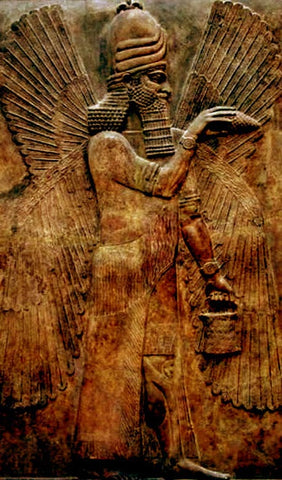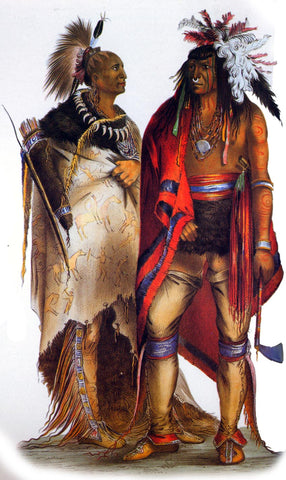The U.S. Constitution owes many of its “novel” notions on democractic government to the Iroquois Confederacy. They quote from Senate resolution 331, from the 100th congress in 1988 (with the link to prove it) in which the Senate acknowledges, “the confederation of the original thirteen colonies into one republic was influenced…by the Iroquois Confederacy, as were many of the democratic principles which were incorporated into the constitution itself.”
In further parsing of that resolution, we find that the Senate’s stated purpose was to “acknowledge the contribution of the Iroquois Confederacy of Nations to the development of the United States Constitution and to reaffirm the continuing government-to-government relationship between Indian tribes and the United States established in the constitution.” Hear, hear.

The resolution was raised by Senator Daniel Inouye (D-HI), the highest ranking Asian American politician in U.S history, who wanted his government to acknowledge the crucial connection between the Iroquois principles of governance and the birth of the U.S. Constitution. The resolution name checks George Washington and Ben Franklin as being two notable constitutional framers who were “known to have greatly admired the concepts of the Six Nations of the Iroquois Confederacy.” One of those concepts, The Great Law of Peace, was especially significant, and inspirational, to the Founding Fathers.
A 1987 conference held at Cornell University on the link between the Iroquois government and the United States Constitution entitled “The Iroquois Great Law of Peace and the U.S. Constitution.” Convened by the university’s American Indian Studies Program, some 200 scholars examined scholarly and historical evidence that the earth’s oldest democracy isn’t the United States of America, but rather the Six Nation Confederacy of the Iroquois.
A simple search brings up many newspaper articles and scholarly books on the subject of the debt the U.S. government owes in their founding principles to the Confederacy’s template. The 200th anniversary of the constitution, in 1987, saw a spike in such articles, from the Washington Post’s piece, “The Iroquois and the Constitution,” to the New York Times article, “Iroquois Constitution: A Forerunner to Colonists Democratic Principles,” to National Geographic’s “From One Sovereign People to Another.”

When the first Europeans swept into the northeast of the New World, far from finding a organizational blank canvass on which to create a brand new system of government, it should be part of the curriculum for students in the Americas to understand that they instead encountered a highly organized, very powerful alliance of six nations that controlled a giant expanse of territory, from the St. Lawrence river south into Pennsylvania and west into Illinois. The Iroquois League was, and still is, the oldest participatory democracy on Earth.
New DNA technology has confirmed the reality of a New DNA Haplogroup X in the Mound Builders who later went on to intertwine into the Iroquois North American Indian Tribes.
This is the “real” Anunnaki Nephilim “Holy Grail” Hybrid bloodline that went to America, long ago!

It was not long after my History Channel UFO Hunters show aired in the summer of 2008 I was approached by some interesting poeple who announced themselves by saying they were once known in our past as the Anunnaki and they wanted to speak with me about my blood anomaly revealed on the History Channel. They told me I was a part of their Hybrid Blood line on this planet called the Nephilim.
At that point in my life I had no clue what a Nephilim or Anunnaki even was, this was before the Ancient Aliens show even started in 2009. I remember looking for info on the Anunnaki and I could find very little on the subject back in 2008 but I began to be guided and tutored by both them and a NSA/Lockheed Martin Skunkworks insider who already worked with the Anunnaki in Technology Transfer Programs into related beds of info pertaining to the Anunnaki.

Also remember I did not know of my Iroquois Indian Haplogroup X Heritage at this moment as well. I had not yet met my Biological Mother and had no clue regarding my heritage or nationality due to my being adopted.
Interestingly enough I have recently found out that the famous physic Edgar Cayce predicted exactly everything I have just shared with you and how new DNA technology has confirmed the reality of the Mound Builders being the remnants of the Atlanteans who later went on to intertwine into the Ancient North American Indians.
So my point is the “real” Anunnaki Nephilim Hybrid bloodline went to America, long ago, All these European secret societies think they have the answers and are the keepers of wisdom over humanity, they don’t have shit, you know where the answers are now? with the North American Indians.
Ancient America and Genetic DNA Research – http://www.edgarcayce.org/are/ancient_mysteries.aspx?id=4144

Edgar Cayce mentioned ancient America in 68 different readings. These readings covered migrations to America, mound builders, the Norse, and other events. In Mound Builders: Edgar Cayce’s Forgotten History of Ancient America(2001), his 68 readings on ancient America were extensively analyzed. From these readings, 30 specific statements were found which could be verified by scientific evidence. Of the 30 statements by Cayce, 23 (or 77%) of them have enough support to be considered accurate. Another six statements are, as yet, not supportable by evidence, but could be verified in the future. Only one statement appears to be wrong. Thus, of all of Cayce’s seemingly impossible statements about ancient America, only 3% are definitely wrong. Of the remainder, 77% have been supported by scientific research, and the 20% that remain could be verified in the future.

Several teams of genetics researchers at prominent American universities have been conducting studies on the DNA of Native Americans. Although results from early studies showed the expected Siberian-Asian ancestry of the majority of modem Native American tribes, things took an unexpected turn in 1997 when it was found that a small percentage of modem Native Americans have an unusual type of DNA then known to exist only in a few locations in Europe and the Middle East. Subsequent research indicated that the European DNA was not the result of genetic mixing after Columbus, as the same DNA was found in the bone of an ancient American burial, confirming that people carrying this unique DNA had entered America in ancient times. This unique gene was also found in a small tribe living in the northern Gobi Desert area. The DNA research initially seemed to promise solid proof of not only where the ancient Americans came from, but also when they came.
As might be expected, ancient DNA research has become a highly contentious issue with several competing sides. Most of the DNA research on Native American Indians has been done utilizing mitochondria. Every cell in our body contains hundreds to thousands of these tiny, football-shaped organelles. The mitochondria process glucose (sugar) into a usable form of energy for all of our body’s functions and are believed to be an evolutional form of bacteria that adapted into a symbiotic relationship with multi-celled life forms. The mitochondria have their own unique DNA, which is simpler and easier to analyze than the human DNA found in the nucleus. Mitochondrial DNA (usually abbreviated as mtDNA) is passed to offspring only through the woman’s egg. Thus, it is not a combination of male and female genes but a haploid gene, meaning that it has only one dose of chromosomes.
Mitochondrial DNA

The haploid mitochondrial DNA shows only the female lineage of a person. Diploid genes are two sets of combined chromosomes, the female set coming from the egg, the male chromosomes from the sperm. Mitochondrial DNA (mtDNA) is categorized into several types and groups termed haplotypes and haplogroups. That is, there are variations in the genetic cycle of mitochondria that fit into clusters. These clusters can trace lineage far back into time. There are 39 different, distinct mtDNA groups into which all humans fit and there are variations on these types. While mtDNA analysis is not only easier than other forms of genetic testing, it has a further advantage. While all DNA mutates over time, mtDNA has a fairly steady rate of mutation that permits a reasonably accurate estimate of exactly when a particular group of people migrated from their primary group.
Two important factors can be determined through analysis of mtDNA. First, a living person or the mtDNA from the remains of a deceased person can be tested to determine the specific racial group from which the individual came. Second, the approximate time when that individual’s ancestors migrated from their primary racial group can be determined.

One way to view mtDNA testing is that it may be able to provide a racial family tree extending back to the beginning of humanity. The current idea in mtDNA analysis on the female side can eventually be traced back to a genetic “Eve.” The 39 types of mtDNA were presumably derived from this Eve. Whether this idea will be completely confirmed by research remains to be seen. Testing to date has confirmed several oral traditions passed down through many generations in several tribes. For example, the indigenous people of Hawaii and Polynesia have long asserted that their ancestors frequently traveled back and forth. Genetic testing showed that these two groups were related and confirmed the migratory legends of these peoples.
Confirming the Siberian Migration
The first research on living Native American tribes showed they were composed of four distinct mtDNA haplogroups called A, B, C, and D which means that the Native Americans are derived from four different lineages. These haplogroups were also found in native populations in Central and South America. Other mtDNA research utilizing ancient remains recovered in the Americas validated these four haplogroups. Three of these haplogroups, A, C, and D are found primarily in Siberian Asia. The B haplogroup, however, is found only in aboriginal groups in Southeast Asia, China, Japan, Melanesia, and Polynesia.
Based on the mutations found in the mtDNA, most researchers think that groups A, C and D, entered America from Siberia across Beringia some time around 35.000 B.C. Group B, they assert, probably came to America from the South Pacific or Japan via boats. It is believed the B groups began this migration not long after the A, C, and D groups arrived. However, the majority of the B group arrived about 11,000 B.C. This leaves open the possibility of several migrations by the B group from different locations.
It should be noted that a few geneticists have proposed that each of these haplogroups came in four separate migrations while many Clovis supporters argue that all the groups migrated together.

An Unknown and Unexpected Migration Group Confirmed
In 1997, a fifth mtDNA haplogroup was identified in Native Americans. This group, called X is present in three percent of living Native Americans. Haplogroup X was not found in Asia, but was found only in Europe and the Middle East where two to four percent of the population carry it. In those areas, the X haplogroup has primarily been found in parts of Spain, Bulgaria, Finland, Italy, and Israel. A few people with the X type have been identified in the Altasians tribe located in extreme southern Siberia in the Gobi Desert area. In addition, the ‘X’ type has now been found in the ancient remains of the Basque people.
Archaeologists and geneticists are certain that the presence of X in America is of ancient origin and not the result of historic intermarriages. Among Native American tribes, the X haplogroup has been found in small numbers in the Yakima, Sioux, and Navaho tribes. It has been found to a larger degree in the Ojibway, Oneonta, and Nuu-Chah-Nulth tribes. The X haplogroup has also been discovered in ancient remains in Illinois near Ohio and a few areas near the Great Lakes. It has not yet been found in South or Central American tribes including the Maya. The X haplogroup appears to have entered America in limited numbers perhaps as long ago as 34,000 B.C. appearing in much greater numbers from 12,000 B.C. to 10,000 B.C.
It is important to note that not all Native American tribes have been categorized by mtDNA analysis and that relatively few ancient remains have been tested.

Mitochondrial DNA (mtDNA) haplogroup X testing led to the surprising hypothesis that some of the first Americans came from Europe thousands of years ago.
The Origin of the Other Haplogroups
The B haplogroup, found only in aboriginal groups in Southeast Asia, China, Japan, Melanesia, and Polynesia, may represent Cayce’s people of Mu. Both Chinese and Japanese archaeologists take the idea of Mu seriously, and the B haplogroup findings closely match the story Cayce told about the continent. Most of the people of Mu who escaped the destruction in 50,000 B.C. escaped to China, India, and Japan. Some time later, descendants of these peoples could have traveled to America. While Cayce said that some people from Mu entered the Americas about 50,000 B.C., he did not indicate that date as the time period when the majority of them came. We only know that it was after 50,000 B.C. and prior to 28,000 B.C.
The Cayce readings do indicate that people entered the Americas from both the east and west in 28,000 B.C. from Atlantis, China, and from “across the Pacific.” The 28,000 B.C. date matches well with the haplogroups A, B, C, and D proposed dates of entry into America. The Cayce readings do have references to the Bering Straits, but Cayce did not relate that there were migrations across it. In fact, no one ever thought to ask him about this, so it remains an open question in the Cayce story. But the A, C, and D haplogroups clearly originated in Siberia just as the archaeologists have speculated. Cayce stated that the “yellow” or Mongol race of humanity originated in the Gobi and gradually spread throughout Asia. Thus, according to Cayce, haplogroups A, C, and D probably originated in the Gobi and would be the migrations Cayce cited as coming from across the Pacific.

The Significance of mtDNA Research Into Iroquois DNA
The mtDNA research confirms most of the other new findings in archaeology. The Americas were settled early and by many different racial groups. Several different waves of migration probably occurred. The initial wave seems to have occurred around 35,000 B.C. However, it may have been far earlier since some radiocarbon dates that have emerged from areas like California and the southwest point to 50,000 B.C. The picture mtDNA research findings paint of ancient America is astonishing. The widespread presence of the X type from Canada and Washington State, to Arizona, to the Plains, to the Great Lakes area, could indicate a wide initial dispersal. The X type in ancient America appears to be linked to the Iroquois.
This tribe, of course, was, according to Cayce, partly the remnant of Atlantean survivors from its final destruction about 10,000 B.C. The finding of the X group in the north Gobi-dwelling Altasians is hailed as proof that all American migrations came from Siberia via the Bering Straits, yet it seems unlikely. With the X type being present in the Middle East, Europe, the ancient Basques, and America, a migration from the Gobi to all of these areas is doubtful.
The Cayce readings cite a series of large and small migrations of Atlanteans to very specific parts of the world. These migrations occurred at several times, but especially during the years approaching 10,000 B.C. One of these places was to the Gobi in extreme southern Siberian Asia. If we assume that haplotype X originated from Cayce’s Atlantis, some of the X haplotype should be found in the Gobi region— but very little of this group should be found elsewhere in Siberia. This is what has been found.

Cayce indicated that the largest migration from Atlantis occurred just before 10,000 B.C. The majority of these Atlantean survivors went to the Northeastern coastal areas of America and Canada becoming the Iroquois. It should be recalled that Cayce also stated that not all of the Iroquois were Atlantean. The Atlanteans migrating to the Americas merged with the people already present in America by that time. The Atlanteans became leaders of the tribes and Cayce’s story makes it clear that the Atlanteans had serious disputes among themselves that were reflected in ongoing violent conflict. This was the struggle between the Belial and Law of One groups. This is confirmed by the Iroquois’ ancient history that tells of constant battles resulting in distant displacements of entire tribes to ensure their survival. Perhaps the most astonishing confirmation of Cayce’s story of ancient America is the presence of haplogroup X. What is known is that the X haplogroup first showed up in America perhaps 34,000 years ago, but its main entry occurred in 10,000 B.C. matching Mr. Cayce’s time frame for Atlantean migrations. The X group also appears to have shown up in ancient Iberia and in the Basques about the same time as well as in the Gobi. These dates match Cayce’s story of the final two destructions of Atlantis and the resulting migrations to these areas.
UFOTV® Presents – ANCIENT ALIEN MOUND BUILDERS
Iroquois Indian Connection To Star Visitors And The Formation Of America!
Lost Ancient “Mound Builder/Nephilim” American History!
The Nephilim In The Ohio Valley! – Anunnaki/Human “Hybrids” in Ancient North American Indian Tribes!
Serpent Mound – Ancient Aliens in America?








